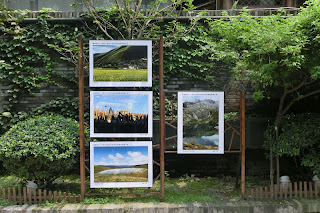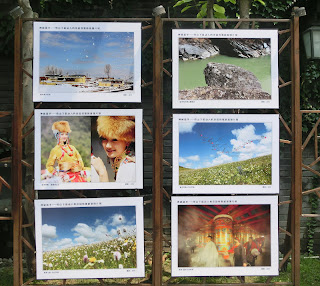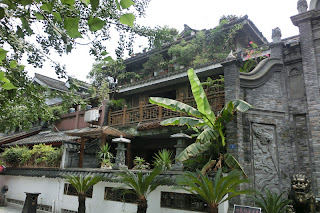Three years ago, I went to Sichuan with a Taiwanese friend. We visited Jiuzhaigou 九寨溝, Huanglong 黃龍, and a Tibetan village nearby. I thought Jiuzhaigou was the most beautiful place on earth and vowed to return to it one day. This time, I did not manage to get to Jiuzhaigou again since I wanted to save the experience for another season -- hopefully winter. I met up with my friend in Chengdu, flying in from Taipei.
We stayed at Sim's Cozy Hostel, a hostel that I would strongly recommend since the rooms are cheapish (about 170 RMB per room), their friendly staff speak English, and their rooms are simple but clean. It was quite a luxury to find a hostel with clean, un-stinking toilets, and I felt extremely grateful about our good luck.
By that time, my friend had already explored Jiuzhaigou and Pingle by herself so we were deciding what to do for the remaining four to five days in Sichuan. We looked at the various sites -- Emei Mountain 峨嵋山, Siguniang Mountains 四姑娘山, Daocheng and Yading 稻城亞丁, and Bamboo Sea 蜀南竹海. We wanted to go somewhere away from the Chinese tourists since it was August, the tourism peak season so Emei Mountain got eliminated almost immediately. Daocheng and Yading were highly recommended but since they were a bit too far away, we could not make it within three days. In the end, we decided to go to Siguniang Mountain since it would be somewhat doable within three days. However, we did not know what we had in store for us.
We asked the hostel to book a car for us (they would then get some other tourists going the same way to split the costs with us). The next morning, a normal looking car came to pick us up. We started out with just three people -- my friend and I plus a British guy. The driver was a middle-aged Chinese lady who seemed very flexible with both her time and our time. She was late for about an hour, picked up packages from friends or customers along the way, picked up another passenger without informing me, and took about one and a half hours to just get out of the city.
The ride to Siguniang Mountains was quite an adventure. It was the scariest road I had ever been on. We went through Wen Chuan 汶川 where the earthquake ravaged much of Sichuan. Piles of rocks were strewn along one side of the route, and on the other was the river bed. The road looked as if it would either suddenly get devoured by the mountains or just simply slide into the riverbed. We came to the beginning of this seven kilometer section and were held back by the police. We got out of the car and stood around doing nothing as did dozens of other drivers and passengers. But our driver talked to her friends and they discussed the situation energetically and within half an hour, we were on our way again. I asked our driver what happened, and she told me that she knew someone who knew someone who knew the police so the police let us through the pass. I was not sure whether I should feel privileged or placed in danger as we bounced around in our seats.
We arrived in Siguniang a good seven hours later (the hostel asked us to wait for the driver in the lobby at 8 AM, she arrived at 9, we got out of Chengdu by 10, passed through the earthquake site by noon, and arrived at Siguniang close to 5 PM). Siguniang is about 3500 to 4000 meters above sea level. I did not suffer from altitude sickness so long as I did not try to walk. I could walk about ten steps before I would run out of breath and pant. We stayed at a nice cheap hostel called Ri Yue Shan Zhuang 日月山庄 (about 150 RMB per night for a twin bed room; they also have rooms around 60-80 RMB per night but it has a squatting toilet).
There are three "valleys" or three routes in Siguniang. We decided to go to Chang Ping Valley 長坪溝 since the entrance to the Valley was within walking distance from our hostel. We took the park bus into the Valley for about five to ten minutes. Once inside, you can either go on foot or rent a horse (to the Withered Tree Banks 枯樹灘, a one and a half hour journey, it would cost about 150 RMB, and if you go all the way, return journey six hours, it would cost about 320 RMB). My friend wanted to walk but since I could barely walk for ten steps without panting, I decided to rent a horse. We went our separate ways.
Renting a horse included renting the Tibetan guide who took the horse's rein and walked in front of the horse as well. The first section of the journey to the Withered Tree Banks was quite smooth but the second section was a bit more rugged and would only be suitable for people who were more physically fit, especially when you take into consideration the lack of oxygen. I tried striking up a conversation with my Tibetan guide, a sixty-some-year-old but very healthy, sturdy-looking lady but her accent was so strong I could only pick out about 10 percent of what she was saying. I only gathered this much: that she had two daughters (the one-child policy does not apply to the minorities) who both studied medicine; that her horse was usually not used to farm but was used to go on Chinese-herbal-medicine-picking trips deep into the mountains; that she worked as a horse guide in the summer and farmed in the three other seasons; that she earned just a bit more than half of what we paid the tour company; that she could work as a horse guide once a week during the summer since there were too many guides and not enough tourists; that the horse was hers and that it was her only horse. I really wanted to talk to her more but I had to guess and really concentrate when I chatted with her.
I would strongly recommend my hostel since they had a very nice terrace on the first floor. The river ran right past the hostel and the mountains loomed straight above. I would just sit and enjoy a nice big pot of tea and look at the mountains. They even had wireless so I managed to skype with my friends back in the UK.
I would strongly recommend my hostel since they had a very nice terrace on the first floor. The river ran right past the hostel and the mountains loomed straight above. I would just sit and enjoy a nice big pot of tea and look at the mountains. They even had wireless so I managed to skype with my friends back in the UK.
In the middle of the night, I found that I often woke up just to take a couple deep breaths. I constantly wriggled around and tried to sleep sitting up since it was easier to breathe that way.
Most people who make the way to Siguniang eventually continue on to Danba 丹巴 but we had to return to Chengdu on the third day to catch our flight to Zhangjiajie, Hunan. The ride back to Chengdu was not as eventful though the driver was much chattier. I asked him whether he was afraid that rocks would fall off the mountains and hit us as we passed through the earthquake area. He replied, "Nah, we can't have such bad luck, can we? Well, if we get hit by rocks then we can't avoid fate anyway." Then I asked whether he would not try to pass through this region if it were raining. He replied, "Nah, we still go through. We have to." Then I asked whether he would still go through the earthquake site during snowy winter. He said, "Yes, I change my tires in the winter. Otherwise the tires won't grip the ground." Then I asked whether there was anything that could stop him from trying to go through. He thought about it and said it with this look of reminiscence that made me quite fearful that it was based on personal experience, "When there is a flood, the river rises and floods onto the road." He pointed at the road ahead. "The water covered the tunnel." He pointed at the tunnel we were going into. "It is not just dangerous. You can't even pass through!"
Once back in Chengdu I felt as if I was back in civilisation again but at the same time, the air was bad and there were people everywhere. You just can't have everything.
I made one final trip to the Narrow and Wide Alleys in Chengdu. It was built in the Qing Dynasty (18th century or so) and then rebuilt in the 21st century according to the ancient Chinese architectural style. It was very touristy but still very pleasing. The restaurants were rather expensive (three dishes including one meat dish, about 150 RMB) but many of them had evening or sometimes even afternoon Sichuan opera or Chinese instrumental music performances. So if you calculate the performance, it is quite well worth the money.
Finally, a note on Sichuan food. It is very very spicy with a numbing effect. But once you get over the shock, the food is very tasty.
The Starbucks in China is also well worth a visit -- their macha latte and coconut frappucino cannot be found in Europe. Finally, Starbucks in a traditional Chinese building with tea-shop atmosphere is also quite interesting.























































